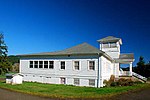Ritner Creek

Ritner Creek is a tributary of the Luckiamute River in Polk County in the U.S. state of Oregon. The creek begins near Bald Mountain in the Central Oregon Coast Range and flows generally southeast to meet the Luckiamute southwest of Pedee and north of Kings Valley. The confluence is 31 miles (50 km) upstream of the Luckiamute's mouth on the Willamette River. Named tributaries of Ritner Creek from source to mouth are Sheythe, Love, Clayton, and Kinsey creeks.Ritner Creek passes under Oregon Route 223 just before entering the river. The Ritner Creek Bridge, a 75-foot (23 m) covered bridge, carried the highway over the creek until 1976. Replaced by a concrete span, it was the last covered bridge on an Oregon state highway.
Excerpt from the Wikipedia article Ritner Creek (License: CC BY-SA 3.0, Authors, Images).Ritner Creek
South Kings Valley Highway,
Geographical coordinates (GPS) Address Nearby Places Show on map
Geographical coordinates (GPS)
| Latitude | Longitude |
|---|---|
| N 44.728611111111 ° | E -123.44333333333 ° |
Address
South Kings Valley Highway 14171
97361
Oregon, United States
Open on Google Maps









